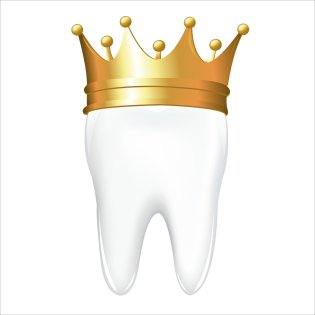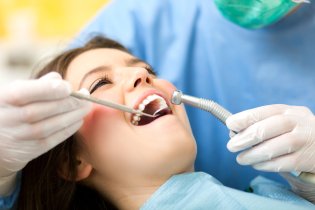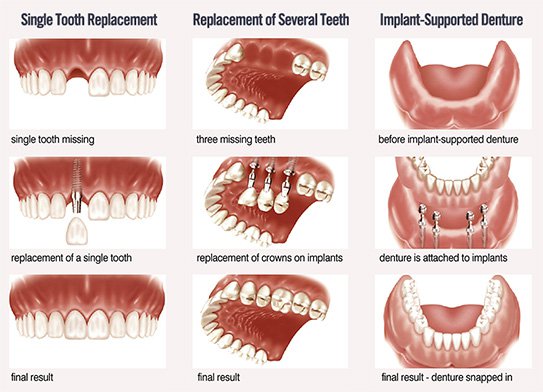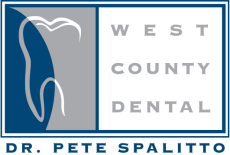-
Teeth in a Day: Same-Day Cosmetic Dentistry [INFOGRAPHIC]
Cosmetic dentistry can give you a smile you’re proud to show off, but some people shy away from getting the procedures they want because they can’t commit the time needed for multiple appointments. Now there is an answer: same-day cosmetic dentistry. With this approach, you can get everything from same-day dental implants to same-day crowns, so your new smile is ready for its debut after a few hours in the dentist’s chair. There are plenty of benefits to choosing a same-day smile, from less time at the dentist’s office to a shorter recovery period. You’ll also save money since you only have to pay for one appointment. In this infographic, West County Dental, which provides same-day dental implants in St. Louis, explains what to expect from same-day cosmetic dentistry. Help spread the word about how easy it can be to get a new smile by sharing this information with your family and friends.
-
The Benefits of Same Day Crowns
 The Benefits of Same Day Crowns
The Benefits of Same Day Crowns Getting crowns used to be an expensive and time-consuming endeavor. Fortunately, advancements in tooth restoration technology make it possible for your St. Louis dentist to design, build, and place custom restorative devices in a single visit using color-matching ceramic.
There are numerous benefits of receiving same-day crowns . One advantage of this approach is that there is no need for temporary restoration and that there are fewer injections and less discomfort overall. Same-day crowns are completed in a single dental visit, which means you can spare the time and inconvenience of scheduling multiple appointments. Another advantage of same-day crowns is that more natural tooth is saved, which can improve long-term oral health.
-
Tips for Choosing a Dentist
 Tips for Choosing a Dentist
Tips for Choosing a Dentist There are a lot of dentists to choose from in St. Louis, but some are better than others. You should take every precaution to ensure that your dentist is experienced, professional, and able to perform the services you and your family need. Whether you need a cosmetic dentist for teeth whitening, an oral surgeon to perform a dental implant, or you simply need a checkup, these tips will help you find a dentist you can trust in St. Louis .
Ask Around for Recommendations
You trust your friends, family, and neighbors when they make recommendations about which movies to see and which new restaurants to check out, so why not ask them for a dentist recommendation? Even if your friends and family don’t have any dentists to recommend in the St. Louis area, they will almost always tell you which dentists to avoid.Look for a “Full-Service” Dental Practice
There are a lot of “specialized” dental practices in St. Louis, especially of the cosmetic variety. You could drive all around town to different practices, or you could find a dentist that offers all the services you need. West County Dental, for example, provides everything from teeth whitening and Invisalign to oral surgery and dental implants. Once you build a relationship with your dentist, you will be happy that you don’t need to go anywhere else to undergo a special treatment.We Accept Most Dental Insurance
Most traditional insurance plans (sometimes called “indemnity plans”) allow you to choose any dentist you desire. Other plans list specific dentists in your network. If your plan does not allow you to choose your own dentist , make sure the dentist is covered by your insurance policy. And remember that dental insurance doesn’t typically cover 100% of the cost associated with major dental services, so look for a dentist that offers no interest and extended payment plans. -
West County Dental Patient Review
See what patients have today about West County Dental in this 5- star Healthgrades review!
-
What is Oil Pulling?
Oil pulling seems to be one of the latest and greatest craze, said to benefit oral health and systemic health. What is oil pulling? Where did this craze come from? What are the benefits, and are they real?
What is oil pulling?
Oil pulling is done by placing about a tablespoon of cold pressed organic oil (sesame, coconut, sunflower or olive oil) into your mouth and swishing the oil around for about 10-20 minutes, then spitting it out. First, the oils mix with the saliva, turning it into a thin, white liquid. Lipids in the oils begin to pull out toxins from the saliva. As the oil is swished around the mouth, teeth, gums and tongue, the oil continues to absorb toxins, and usually ends up turning thick and viscous and white. Once the oil has reached this consistency, it is spit out before the toxins are reabsorbed.
Oil pulling is an ancient Ayurvedic remedy for oral health and detoxification. Benefits of oil pulling not only occur in the mouth, but supposedly, throughout the body, in many ways. It’s well known that Vitaman E oil is used to help sooth gums and clove oil is used to help with tooth aches, so why not use unrefined oils, such as coconut or sesame, to help improve your oral health? Even though, there is a lack of scientific research and proof, many people have reported several benefits of this craze.
What are some of the oral health benefits of oil pulling?
- Inhibits the growth of many bacteria found in the mouth
- Moisturizes the mouth (dry mouth is a leading cause of tooth decay and gum disease) – also moisturizes lips
- Prevents halitosis (bad breath)
- Mentions of strengthening teeth, gums and jaw muscles (possibly also help with TMJ)
- Natural tooth whitener
Possible benefits of overall health:
- Migraine headache relief
- Decrease sinus congestion and allergy symptoms
- Helps detoxify the body of harmful metals and organisms
- Aid in pain relief
So, how do you “oil pull”?
- Brush and floss your teeth as normal
- Take one tablespoon of oil (such as coconut, sesame, sunflower, etc.)
- Swish for about 10-20 minutes
- Spit out oil, then rinse mouth with clean water
With so many people becoming more conscious about their health these days, a lot of them are trying more holistic approaches to better health. Even with a lack of scientific research on oil pulling, many people are trying this method to help improve their oral and overall health. There have not been very many reports of negative oil pulling side effects, so this “craze” may really be worth the try. It has been shown that swishing with some of these unrefined oils, causes a decrease in the production of certain bacteria that lead to tooth decay and gum disease. Don’t let oil pulling become your only means of preventative dental care, but it may help to add it to your daily routine.
-
The Seriousness of Gum Disease
Have you been to the dentist lately and been told that you have gum or periodontal disease? Did they tell you that they would like to see you more often? Don’t stress, you’re not alone. More than 80 percent of the United States adult population has some form of gum disease, which is a bacterial infection of the gums. Gum disease may not seem like a big deal, but when left untreated can lead to tooth loss.
The biggest cause of gum disease is the buildup of plaque, but some of the other causes are things such as poor homecare, genetics, smoking, stress, clinching or grinding, hormones, medications, and diabetes. There are signs of gum disease; it can start as halitosis, or bad breath, with other signs such as irritated or bleeding gums, pain when chewing, and/or separation of gums from the teeth. There are several stages of periodontal disease: it begins with gingivitis and is followed by early, moderate, and advanced stages of periodontal disease. Periodontal disease cannot be cured and will never go away on its own, but it can be improved and maintained.
Your dentist or hygienist may recommend a deeper cleaning such as scaling and root planning, or gum therapy. This type of cleaning includes the removal of plaque, calculus and staining from the crown and root surfaces of teeth, and can only be performed by a trained dental professional. Your hygienist might decide to use a laser to help in the gum therapy process. For more information and a list of benefits of using a laser, check this out: http://www.westcountydental.com/Procedures_LaserDentistry_6001991/
After you have had gum therapy, your hygienist will want to see you in four to six weeks for a follow up to check on the improvement of you gum health. Another thing that may be recommended is an oral antibiotic or the placement of an antibiotic below the gums to help heal the infection. The hygienist might also ask you to come more frequently, whether it’s in three, four, five, or six month intervals. This is also to monitor your gum infection and to help you stay on track with your homecare.
The days of thinking that you only need to see your dentist every six months was created by a toothpaste company, not by dental professionals. Periodontal disease is a serious thing among many Americans, so don’t ignore the signs; work on getting your gums healthy. Please don’t think that your dentist is just trying to get more money out of you because they’re not; they want to help you, but only if you want to be helped.
-
What can implants do for you?
With today’s changing technology, implants have become a great choice for replacement of missing teeth. In the past, bridges and partials were what replaced those teeth, but the problem is that bridges can be difficult to clean underneath and partials are removable so they sometimes begin to flop around. Also, when partial or bridges are placed, patients lose bone in these areas and things begin to not fit so well.
Now, when someone has a missing tooth, or even several missing teeth, implants become a great option, and they can be used for single crowns, bridges, or even full dentures.
Some of the great benefits to having an implant(s) placed are that the procedure is relatively pain free, and there is very minimal, if any swelling afterwards. Implants also help to preserve bone because they imitate a real tooth, serving as a root in the bone.
Many times when a patient chooses to have an implant placed, their dentist refers them to an oral surgeon for placement of the implant and possible bone grafting, and then the patient has to go back to their general dentist and sometimes a lab to have the implant restored. The great thing about having an implant placed here at West County Dental is that I am able to bone graft, place implants, and restore them to their finished product, all here in our office.
Hear what a couple of our patients had to say about their implant experiences:
Fran had a single implant placed: http://youtu.be/sw1ybejckzw
Val had all of her teeth removed and replaced with implant dentures in one day: http://youtu.be/xy3y-fknvxu

-
A Different View on Dental Xrays
So, I’m sure everyone has heard the stories and read the articles claiming that dental x-rays increase the chance of brain tumors. These articles are telling people that studies have found that annual bitewings, frequent panorex films, and radiographic exposure at a young age all increase a person’s chance of developing meningiomas . The problem is people are reading the headlines and not the details.
A lot of these studies were based on people who have had high exposures to radiation, such as survivors of atomic bombs. As far as the relativity of exposure to dental radiation, the studies were done when higher dose x-ray methods were used. According to Wikipedia, no recent studies have examined associations between dental x-rays and meningioma during the era when radiation doses for conventional x-rays have decreased and newer imaging techniques, such as computed tomography, have been introduced. Here are some comparisons to show just how little radiation is received from current methods of dental radiography:
Some people may ask if dental x-rays are absolutely necessary, and the answer is ABSOLUTELY YES! Although many dentists, such as myself, keep up on today’s quickly advancing technology by using things such as intraoral cameras, lasers, and magnification glasses, we are still unable to see through teeth, gums, and bone. For this reason, x-rays are needed to properly diagnose and treat issues of the mouth. With the proper use of dental x-rays, issues such as cavities, infections, lesions, developmental issues and many others can be detected and treated at an early stage and also help to save time, money, and unnecessary discomfort. Radiographs may be required while a woman is pregnant in order to keep the mother and the fetus healthy, and as long as the mother is properly protected with a lead apron, she and her baby will be just fine. Keep in mind that everyone has different needs when it comes to frequency of dental x-rays, and your dentist will more than likely weigh the benefits and the risks before taking unnecessary radiographs.
Leaded aprons and thyroid shields that contain lead or other materials are patient-protective equipment that minimize exposure to scattered radiation. If all of the NCRP recommendations are followed rigorously, the use of a leaded apron on patients is not required. (National Council for Radiation Protection & Measurements. Radiation protection in dentistry. Bethesda, Md.: National Council for Radiation Protection & Measurements; 2003.) However, if any of the recommendations is not implemented, then a leaded apron should be used.
Really, dental x-rays should not be feared or refused, but rather looked upon as a great form of technology that can help to properly detect and treat dental issues and concerns. If you have any question about dental radiographs, feel free to ask your dentist about them.
RECENT POSTS
categories
- Uncategorized
- crowns
- dental veneers
- dentists
- full service dental practice
- porcelain veneers
- same day crowns
- Dental Cosmetic Surgery
- Dental Implants
- Dentistry
- Dentist Review
- Laser Dentistry
- Root Canal
- Sedation Dentistry
- Dentures
- Cleanings
- Teeth Whitening
- Abscessed Teeth
- Cosmetic Dentistry
- Infographic
- Cavities
- Sealants
- Gum Recession
- Periodontal Disease
- Dental Health
- Family Dentistry
- Dental Emergency
- Invisalign
- Filling
- Same Day Dental Procedures
- Gum disease
- Sleep Apnea
Archives
2022
2021
- December (2)
- November (1)
- October (3)
- September (2)
- August (2)
- July (2)
- June (2)
- May (2)
- April (2)
- March (2)
- January (2)
2020
2016
2015
- December (4)
- November (3)
- October (3)
- September (4)
- August (4)
- July (4)
- June (4)
- May (3)
- April (3)
- March (4)
- February (5)
- January (6)

